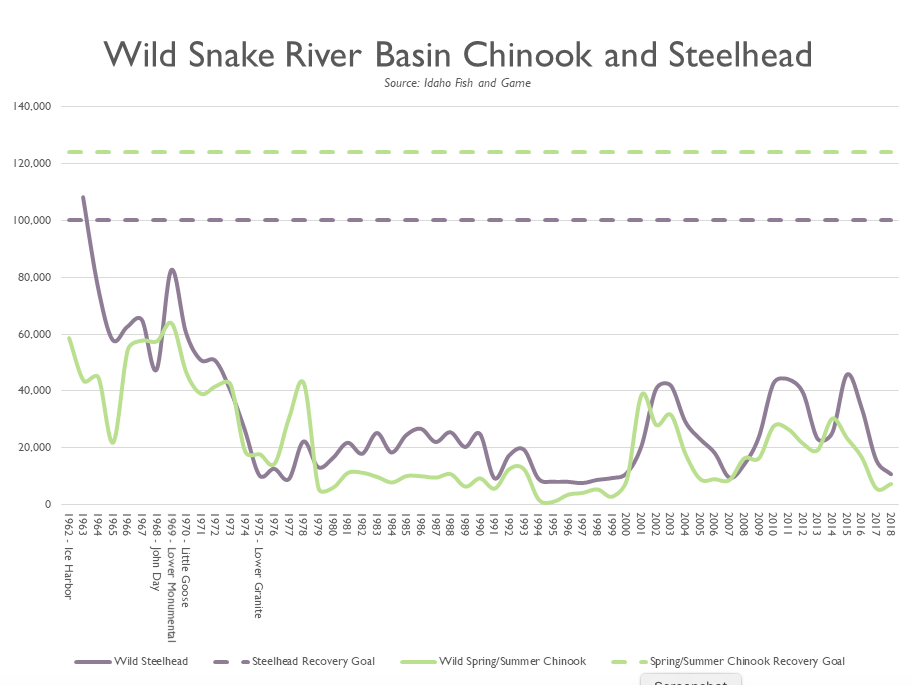forum
library
tutorial
contact

We Need a New Vision
for Salmon -- and the Region
by Liz Hamilton
The Oregonian, August 28, 2019
|
the film forum library tutorial contact |

|
We Need a New Vision
by Liz Hamilton
|
 When people in our region come together to solve big challenges, it's important we're clear-eyed about what our problems are.
When people in our region come together to solve big challenges, it's important we're clear-eyed about what our problems are.
"The Northwest is not winning the battle to save wild salmon and steelhead," Tom Karier recently wrote ("Why Bonneville can't save salmon," Aug. 18).
That clear-eyed assessment is right. Unfortunately, he misdiagnoses the cause, and therefore the questions we should consider.
Contrary to the picture painted by Karier's op-ed, the sport and commercial fish harvest is not a significant contributor to the decimation of our region's iconic species. In 2018, sport and commercial fishing combined accounted for just 1.2% of the Snake River wild spring Chinook take--while these fishers contributed millions to the regional economy.
It's the opposite with dams, including the four dams on the lower Snake River. In fact, in 2018, dams were responsible for killing a whopping 29.8% of the adult spring Chinook salmon returns, as the fish have to navigate above eight federal dams to their natal streams.
Salmon feed us, feed orcas, play a paramount role in Native culture, and contribute more than $3 billion to the Oregon, Washington and Alaska economies each year.
Salmon numbers are bleak. The Idaho Department of Fish and Game reported this month that the Snake River sockeye run is just 6% of the 10-year average. Idaho's renowned B-run steelhead returns are among the lowest in 40 years.
We've known that dams are destroying our most precious fish populations for years. A 2006 federal, state and tribal analysis reported dams are responsible for at least 43% and maybe as much as 74% of human-caused deaths of Snake River wild spring chinook.
Karier -- who served for two decades on the Northwest Power and Conservation Council -- is right to call for more accountability from the Bonneville Power Administration in its salmon recovery efforts. Our region has missed Snake River adult salmon return goals by more than half for more than 20 years. Who gets to miss their performance goals for that long without some sort of significant change? No one in my industry!
When it comes to the battle to save wild salmon, the change we need is a new vision.
Rather than reflexively calling for dam removal or dam preservation, as sides have done for two decades, it's time to ask as a region how we can create a future that restores abundant salmon and steelhead--and preserves our way of life for all the residents here.
I believe we can have a different kind of conversation across the Northwest. Even though I personally believe the science supports removal of the four lower Snake River dams, I'm not interested in old factions winning or losing. I'm interested in approaching this conversation as one region, intent on securing an opportunity for all of us to rise together.
Consider that BPA, which operates the four Snake River dams, faces significant financial hurdles. It's selling less energy to California, just as it's considering spending $1 billion to upgrade those four aging and outmoded dams on the Snake.
We have to ask if that massive cost--which will ultimately hit ratepayers and taxpayers--is worth it.
Can we as a region come together to make the kind of change that will create the better future our children and their children deserve?
A future where fishing is not only the way many families experience the outdoors, but is also a key contributor to a recreation and tourism economy worth billions annually?
Where actions for recovery are, as Karier said, accountable for more salmon returning? Where the BPA modernizes its operations rapidly and becomes a leader for clean, affordable energy, continuing its legacy of providing cheap power to Northwest families?
The region's governors--our own Kate Brown, Washington's Jay Inslee and Brad Little of Idaho--are open to asking these questions and being creative about finding answers that ensure that no one is left behind. Not farmers, not ratepayers, not tribes with treaty rights, and not the robust sportfishing economy and culture. U.S. Rep Mike Simpson of Idaho has called for the same.
This is the kind of vision we need. This is, after all, why we elect leaders: to help our families, communities, and businesses work together to solve problems.
The lower Snake River dams are barriers in more ways than one. They're holding our region back from restoring our most important species and developing abundant clean energy. It's time for our leaders to bring residents together to chart a way forward to preserve salmon, electric power and communities simultaneously.
learn more on topics covered in the film
see the video
read the script
learn the songs
discussion forum
